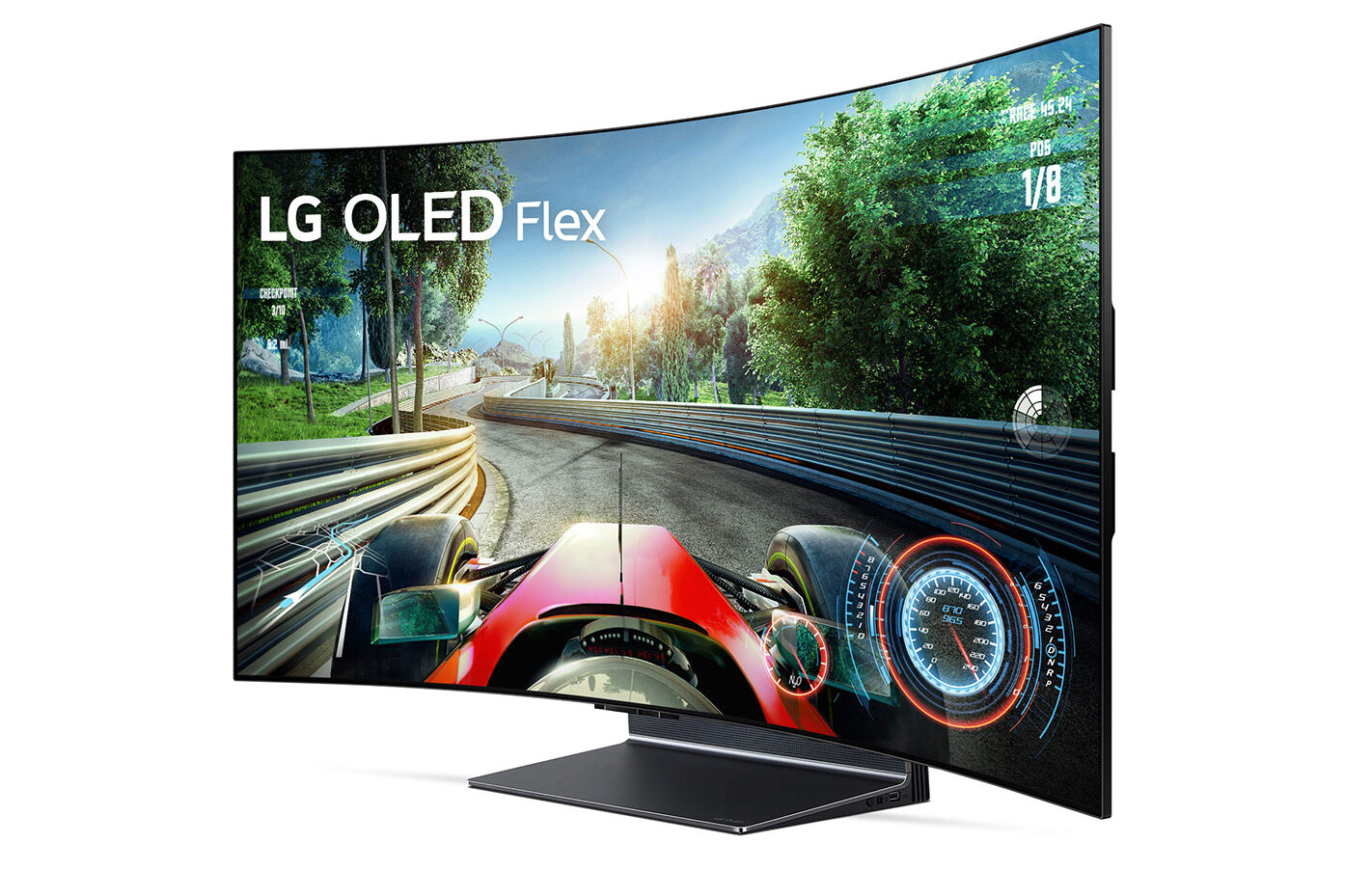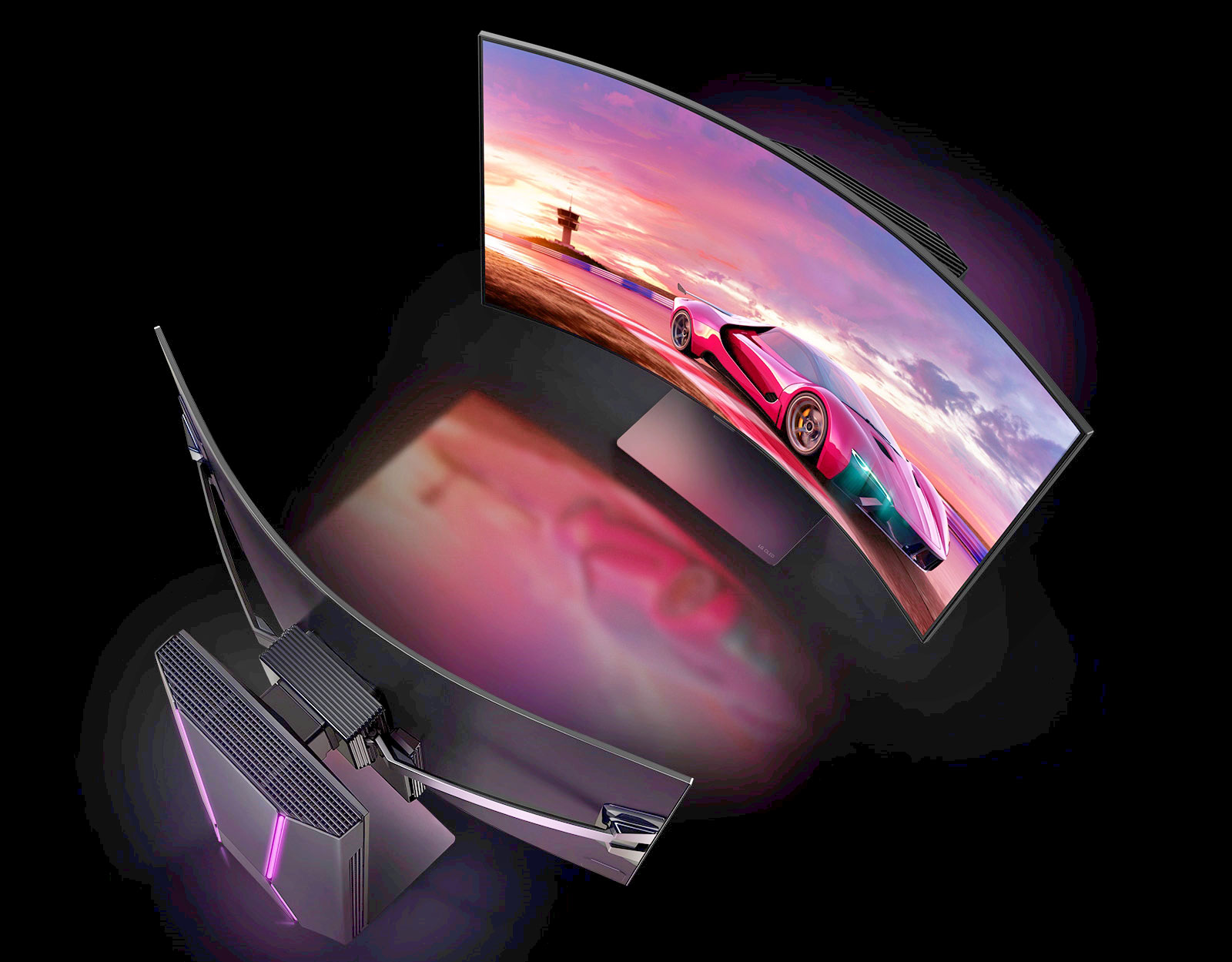LG LX3 Claimed to Be the World’s First Bendable 4K OLED TV
Users can choose from 20 levels of curvature, from flat to 900R.
LG has found a new application for its bendable OLED Flex display technology. The new LG OLED Flex TV (model LX3) is claimed to be the “world’s first bendable 42-inch OLED TV.” Furthermore, the curvature can be controlled between two preset favorites with a click of the remote. This product announcement follows hot on the heels of the Corsair Xeneon Flex 45WQHD240 OLED, a 45-inch manually-flexing gaming monitor announced almost a week ago, and LG’s own UltraGear 45-inch gaming monitor, which offers a fixed 800R curvature.
While the two 45-inch flexible OLED gaming monitors with 3440 x 1440 pixels, 240 Hz, and 0.1ms response times were obviously related, the new LX3 TV uses a smaller 42-inch OLED Flex technology panel with a higher 4K resolution and lower max refresh rate. In addition, LG decided to support user-adjustable curve flexing (like the Corsair monitor). However, unlike the Corsair, it says that the 42-inch display can flex between being perfectly flat and a 900R (not 800R) curvature. Moreover, LG says there are 20 curvature levels a user can set between these flat/curved extremes, and two preset curvatures can be recalled using the supplied remote control.
Some criticized Corsair’s 45WQHD240 for flexing to 800R and, in doing so, forming a soft-V shape rather than a perfect arc. It would be interesting to see if LG’s powered flexing mechanism maintains a true arc or suffers from the same reshaping glitch. We simply don’t know at this time, but this TV will be on show at IFA 2022 starting Friday.
With the unique flexibility and remote-controlled bendability of this TV outlined above, it is time to describe the more regular specs of this device. We’ve already mentioned that LG uses a 4K OLED Flex technology panel here. It offers 3840 x 2160 pixels in a 16:9 aspect ratio. The screen can run at up to 120 Hz, and supports HDMI 2.1 features such as variable refresh rate (VRR) and auto low latency mode (ALLM). Those particularly interested in PC gaming on this TV may be happy to hear it also supports AMD FreeSync Premium, and is Nvidia G-Sync Compatible VRR standards. Several game modes are also supported, with pre-sets for RPGs, racing, RTS, and FPS games – and these can apply changes to both visual and audio settings.
Other niceties about the LG OLED Flex (model LX3) are its; easy to use WebOS UI with app support, USB Hub with quick source switching, Multi-View modes for displaying more than one input source simultaneously, Image Resize adjustment for scaling to a smaller section of the display (e.g., 27- or 32-inches), Wi-Fi 6 connectivity, four HDMI 2.1 inputs, TV tuners, two front-firing 40W speakers with Dolby Atmos, and customizable rear lighting with five A/V sync options. The supplied stand is very adjustable for a TV, with 10/5 degrees tilting and 140mm height adjustment. Don’t forget the flexing from flat to 900R, too.
LG says its OLED Flex TV (model LX3) will be on show at IFA 2022, which runs from Sept 2 to 6, in Berlin. We don’t have pricing or availability at the time of writing, but these details, and a full specifications table might be released to coincide with the event. Once the details have been announced, you'll probably be able to use one of our LG promo codes to bring the price down.
Get Tom's Hardware's best news and in-depth reviews, straight to your inbox.

Mark Tyson is a news editor at Tom's Hardware. He enjoys covering the full breadth of PC tech; from business and semiconductor design to products approaching the edge of reason.
-
husker I'm no math or physics genius but one thing seems obvious to me. In order to flex the screen, the product image shows 3 main contact points: the center and then an arm contacting the 2 side edges. This is similar to having a material subjected to a load applied transverse to the long dimension. This naturally causes the member to bend, similar to how a wooden board on a scaffold with someone standing in the middle would gently bend. When bending the structural material in this manner the resulting curvature is takes on a parabolic distribution, and not a circular one that many may expect or want. This assumes that the material of choice backing the panel (presumably some kind of plastic), has an even coefficient of strength applied across the width. This may or may not be addressed in the marketing of the product, but I wanted to point that out since that can make the curve a bit more V shaped rather than C shaped. But like I said, I'm no math or physics genius.Reply
We haven't ruled out engineering genius, though. -
imsurgical Replyhusker said:I'm no math or physics genius but one thing seems obvious to me. In order to flex the screen, the product image shows 3 main contact points: the center and then an arm contacting the 2 side edges. This is similar to having a material subjected to a load applied transverse to the long dimension. This naturally causes the member to bend, similar to how a wooden board on a scaffold with someone standing in the middle would gently bend. When bending the structural material in this manner the resulting curvature is takes on a parabolic distribution, and not a circular one that many may expect or want. This assumes that the material of choice backing the panel (presumably some kind of plastic), has an even coefficient of strength applied across the width. This may or may not be addressed in the marketing of the product, but I wanted to point that out since that can make the curve a bit more V shaped rather than C shaped. But like I said, I'm no math or physics genius.
We haven't ruled out engineering genius, though.
I'm definitely not an engineering genius, though I completely understand what you're saying after your thorough explanation and analogy. Thank you for that!
Piggybacking off what you wrote, I too believe this is going to be an issue in terms of marketing to the public, the adjustable curve, in that the finer points of it it probably won't be marketed at all or very cleverly, and I personally think that's a problem for the consumer at the end of the day. I think this style of monitor is a fad when it's all said and done and actually hope for it not to be very successful if I'm being honest 😬.

